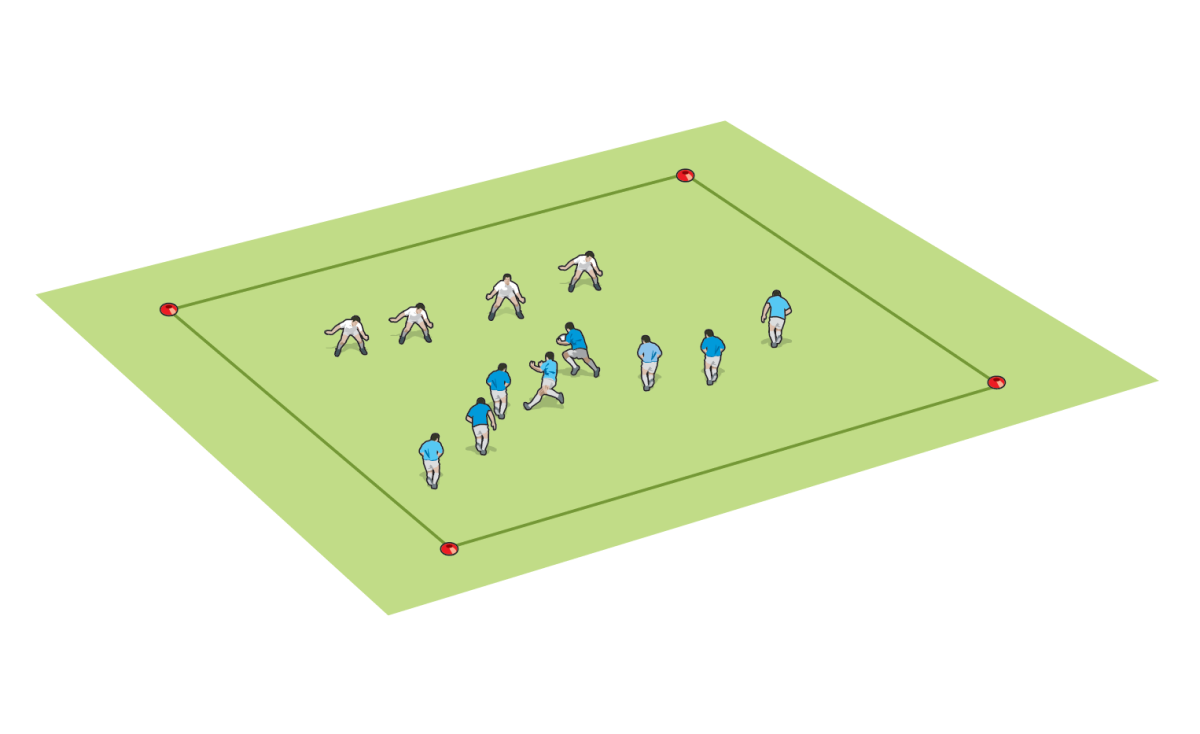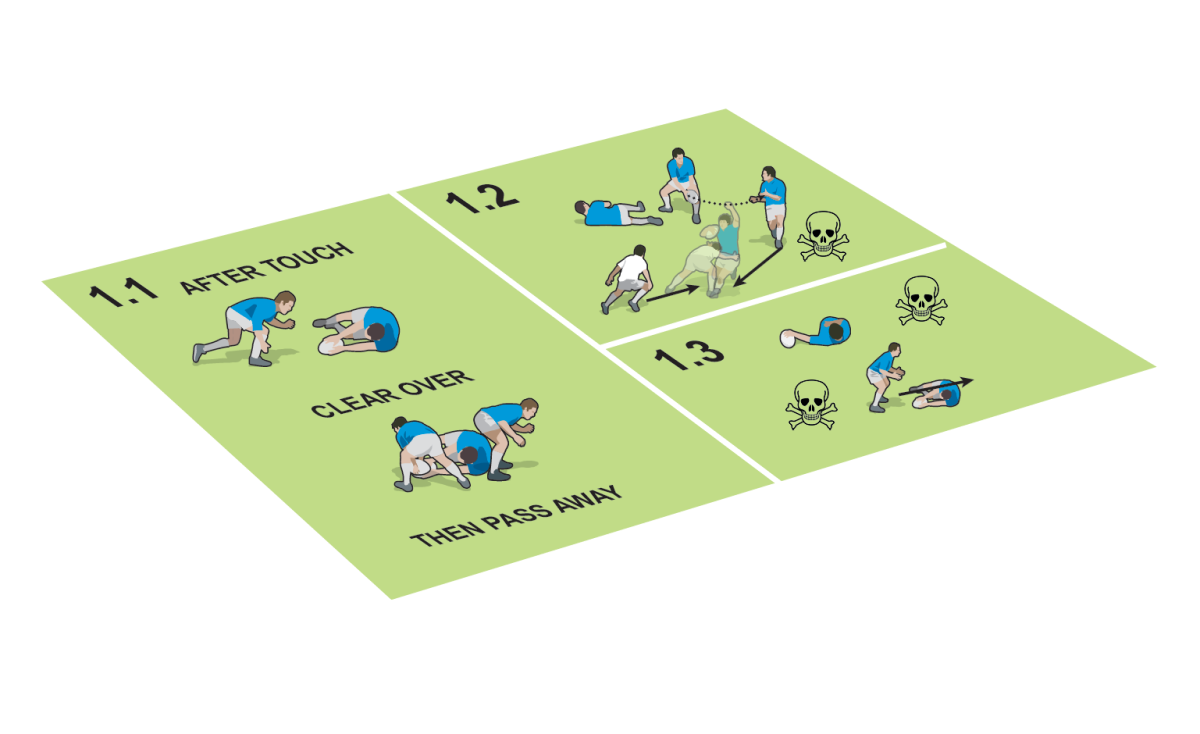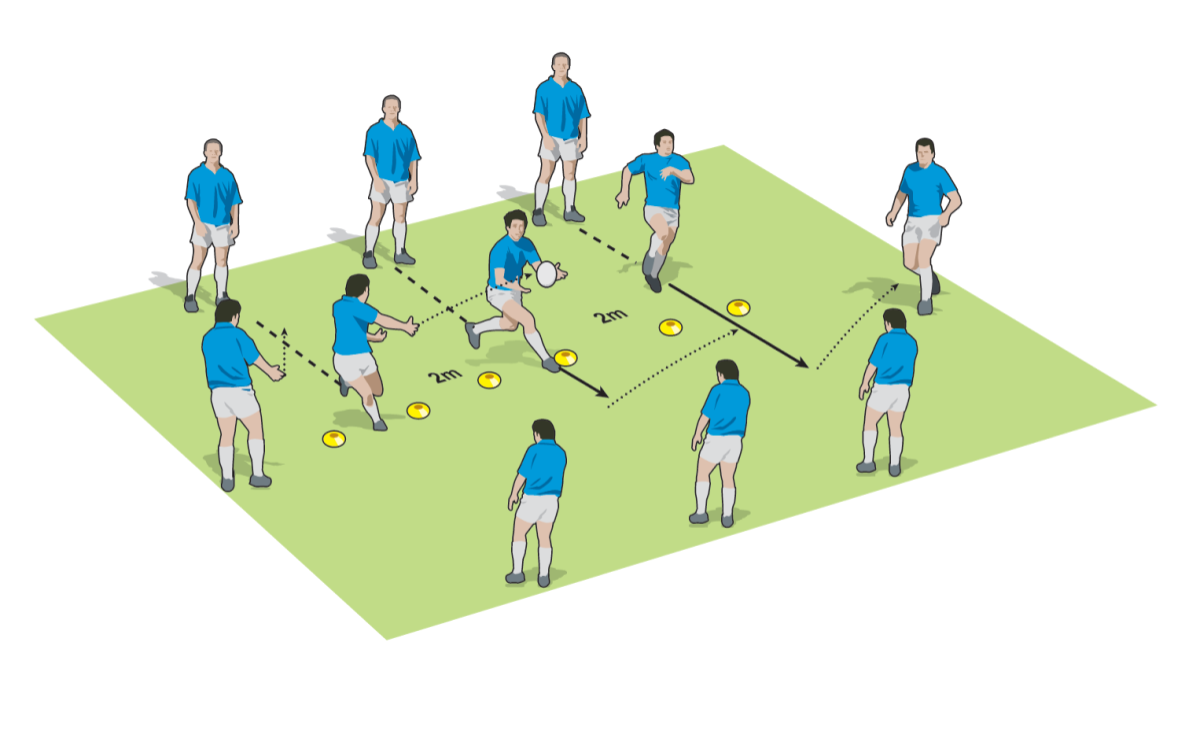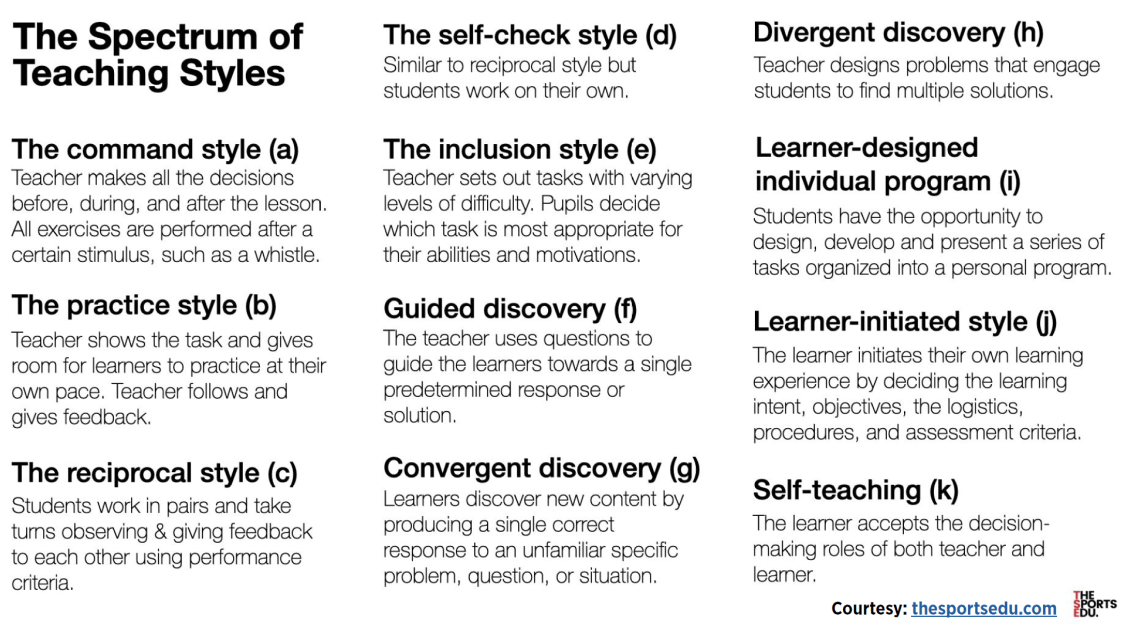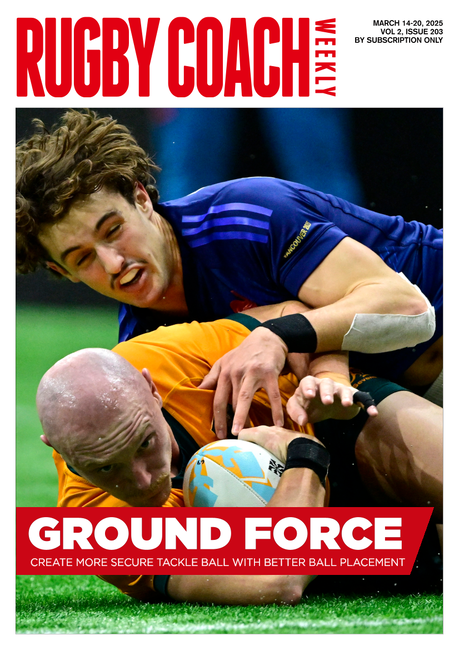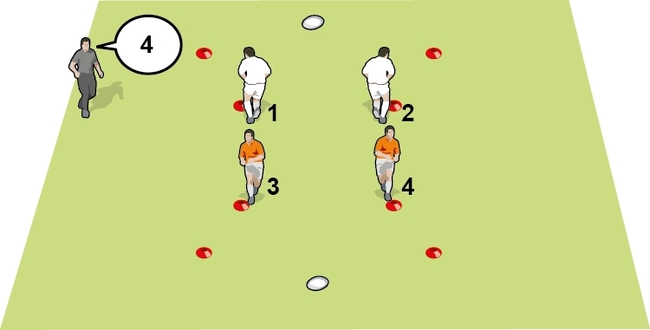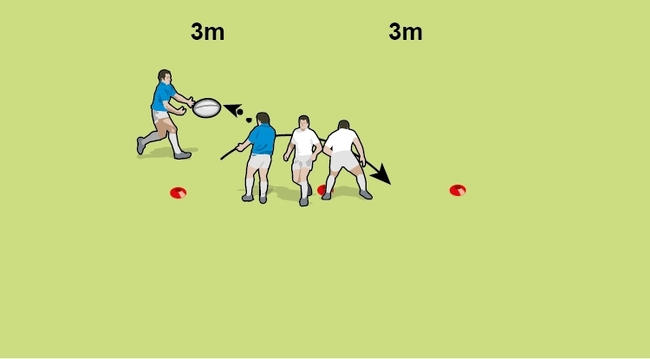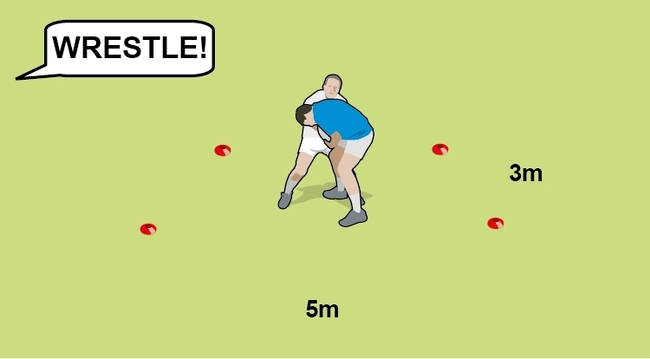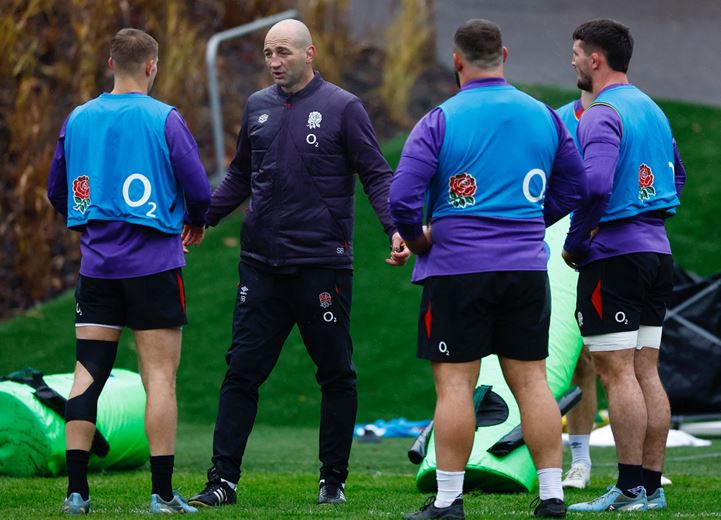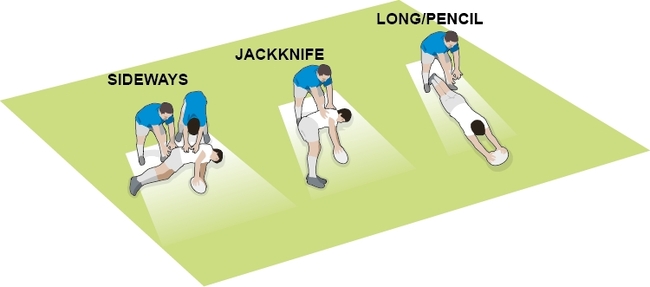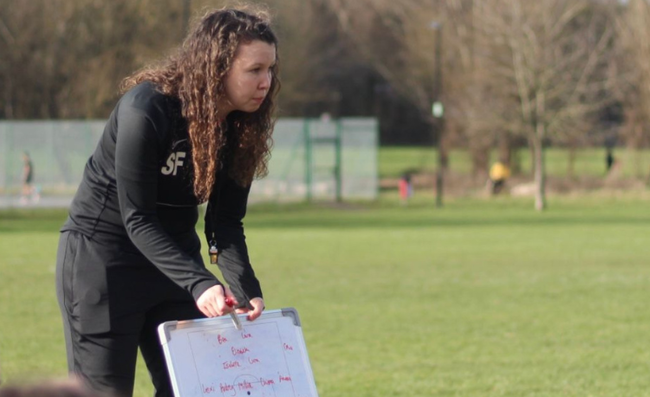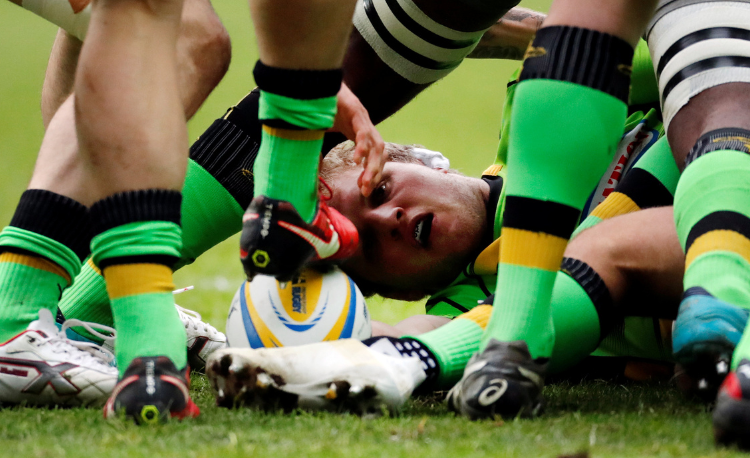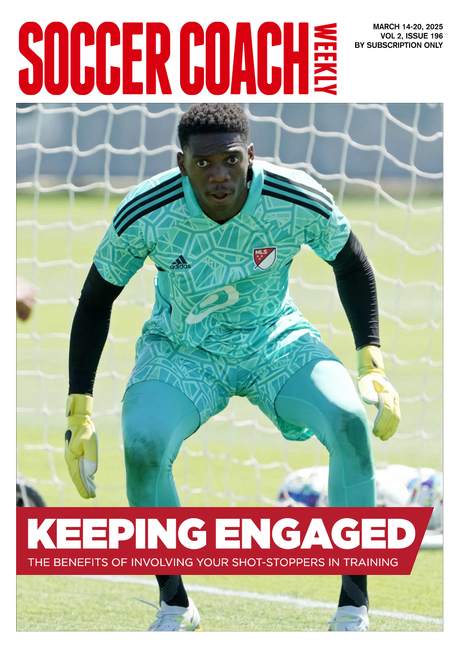Skill zone and game zone core-skill blast
This one-hour session works on skills, using a blend of practice and scaffolding, and guided discovery, and can be part of a longer session.
SESSION THEME
Energised basics to quick play.
SESSION OUTLINE
| TIME | ACTIVITY | COACHING STYLE |
| 10 mins | Warm-up | Practice |
| 10 mins | Game 1.1 | Guided discovery |
| 8 mins | Skill 1 | Practice/Scaffolding |
| 12 mins | Game 1.2 | Guided discovery |
| 8 mins | Skill 2 | Practice/Scaffolding |
| 12 mins | Game 1.3 | Guided discovery |
THE GAMES
All three games in this session will be the AB v C game.
Split your team into three groups, each with a letter. If you have more than 20 players, then run two games.
In each game, two teams combine in attack to play one team in defence.
The attacking team has three lives, and must score as many tries as they can. Once they have lost all of their lives, one of the attacking groups rotates with the defending team.
The game will be touch rugby. When a player is touched, unless they are in the act of passing, they have to go to the ground and present the ball. The next arriving attacking player must clear over the prone ball carrier, before the ball is passed away. There is no kicking.
For all the games, the attacking team loses a life for an attacking infringement, such as a knock-on or going into touch. The defending team gives a life back if they infringe, like a deliberate knock-on.
The versions of each game will include ‘life’ rules, to encourage players to improve their core skills.
LEARNING GOALS EXAMPLE
Game 1.1 Using guided discovery, players discover the effects of moving the ball to space, and the factors that enhance try-scoring opportunities. Ask questions like:
- What effect does passing a long/slow/loopy pass have to the first receiver when attacking?
- What effect does having a small or large distance between the ball carrier and the first receiver have on try-scoring opportunities?
- How can you, as first receiver, make it difficult for the defender to tag you? Where will you stand in relation to the first receiver to make it easy/hard for the defender? Why do you think this happens?
SESSION ELEMENTS
Related Files
GAME 1.1
Play the AB v C game. The players might discover that moving the ball to space creates try-scoring opportunities.
GAME 1.2
An additional rule for life lost is if the first receiver is touched. This puts pressure on the first receiver to pass earlier, promoting better catching and passing. If you have a very good team, you might change this rule, so that touching the second receiver – not the first – loses the life. This changes the dynamic even further, especially for the defensive decisions.
GAME 1.3
An additional rule for a lost life: Poor ball placement, and the first attacking player over the ball has a poor body position. This focuses the players on being accurate even if there’s no real contact involved.
SKILL 1 – CATCH/PASS
- A feeder passes to the first player moving forward
- Each receiver moves forward to catch and pass
- Each receiver moves through the cones in front of them
- The last receiver passes to the next feeder who will feed the facing group
This exercise gives players many chances to catch and pass. You might want to run two, or even three, groups, depending on your numbers.
Three players start in a line, no more than 2m apart. Feed the ball to the first player, who must catch, run, and then pass as they run. The other players repeat.
Once finished, they pass the ball to another feeder, who passes it to the next group. The players fill in the columns to keep the exercise rotating. Change the passing direction after a minute.
Focus on the following: Hands up to receive a pass and keep running square, which means hips facing up the pitch.
SKILL 2 – BALL PLACEMENT AND CLEAR

- A ball carrier and support player stand about 2m apart on a try line
- The support player gorilla crawls over the player on the ground
- The ball carrier steps forward and falls to the ground to present the ball

- A ball carrier, standing 2m in front of the receiver, passes the ball back
- The first ball carrier player moves low and over the player on the ground
- The new ball carrier steps forward and falls to the ground to present the ball
Gives players the confidence to present the ball after contact and the next attacking player to effectively protect the ball.
Split players into pairs, with a ball. If you don’t have enough balls, fours with a ball can rotate.
Put both players facing up the field, about 2m apart on the try line. One player passes to the other, who then goes to ground and presents the ball. The next player has to gorilla crawl over the prone player. They get to their feet, return to the try line, swap roles and repeat.
After three goes each, and checking for good technique, the ball carrier now starts 2m in front of the try line, so the pass is diagonally backwards. Repeat, but the clear-out player now has to remain on their feet as they go over the prone player, emphasising a good height.
COACHING STYLES
In this session, I have identified some coaching styles I will use.
Choosing a specific coaching style is an excellent way to get the players to make specific decisions during that coach’s part of the session, focusing on the players’ learning outcomes.
A different style helps develop different outcomes, and it is also based on the player’s development stage.
Futhermore, it helps the coach consider the language they will use to direct the player to what the coaching objective/goal is for that specific episode.
For example, is it to recall a movement in a specific situation? Or is it to discover, through trial and error, a way to solve a problem that they do not know the answer to?
When a player is less experienced and learning a new skill, you might choose a reproduction style that follows a model of good technique and skill and practices that. This reduces the chances of the players picking up bad habits early in their development.
For more experienced players, who are learning a new move, you would use a style from the reproduction cluster (see styles A-E in the ’Spectrum of Teaching Styles’ illustration, above).
But, if you want the players to create and develop their own plays, it would be drawn from the production cluster of styles (see styles F-K).
Knowing that no one coaching style is better than another is vital. It is more important to choose the one that suits the learning outcome.
Reproduction (styles A-E)
These are coaching styles which give the players a chance to reproduce a skill they have practised before.
Practice: One example, from the reproduction cluster mentioned above, is the practice style, where the players use familiar skills and techniques.
"No one coaching style is better than another. Choose the one that suits the outcome..."
The coach might give individual feedback during this process. Or, if using reciprocal coaching, the players will give each other feedback, either through encouragement or specific ways to improve the skill.
In the session I designed for this article, use the passing exercise to practise an early catch and staying square.
Scaffolding (as part of practice): The coach adds some rules to make the skill easier, before removing them. The players gain confidence in the skill.
In this session, since there are no opposition players in the passing exercise, there are no decisions to make. Adding a defender adds more pressure to perform the skill.
Production (styles F-K)
These are coaching styles which give your team’s players more decisions in their learning. They are, therefore, producing the knowledge.
Guided discovery: The coach plans a target and leads the players to discover it through the use of questioning.
The players already have some knowledge in certain areas. The combination of that knowledge in this part of the session, and the use of questioning by the coach, will lead to new knowledge for them.
This is only guided discovery if the player does not know the answer, or concept, to be discovered, as you cannot discover, or produce new knowledge from, something you already know.
In this session, the games have rules, which means that the players need to execute the skills well, and then learn how these skills either allow them to score tries or prevent them from being scored.
With thanks to Brendan SueSee, senior lecturer at University of Southern Queensland (UniSQ), in Brisbane, and co-author of The Spectrum of Sport Coaching Styles.
Newsletter Sign Up
Coaches Testimonials

Gerald Kearney, Downtown Las Vegas Soccer Club

Paul Butler, Florida, USA

Rick Shields, Springboro, USA

Tony Green, Pierrefonds Titans, Quebec, Canada
Subscribe Today
Be a more effective, more successful rugby coach
In a recent survey 89% of subscribers said Rugby Coach Weekly makes them more confident, 91% said Rugby Coach Weekly makes them a more effective coach and 93% said Rugby Coach Weekly makes them more inspired.
Get Weekly Inspiration
All the latest techniques and approaches
Rugby Coach Weekly offers proven and easy to use rugby drills, coaching sessions, practice plans, small-sided games, warm-ups, training tips and advice.
We've been at the cutting edge of rugby coaching since we launched in 2005, creating resources for the grassroots youth coach, following best practice from around the world and insights from the professional game.

